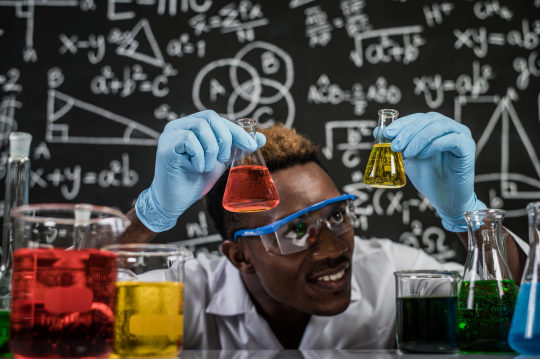#TechXplore
Explore tagged Tumblr posts
Text
Absolutely fascinating development from Creative Machine Lab at Columbia Engineering - and an astonishing accompanying video - of their expressive robot face, which brings an exciting advancement in nonverbal communication - facial expressions - in which robotics has rather lagged behind somewhat.
A lot of interactions are predicated upon recognising and responding to the emotional state of the potential conversant, and Emo has that ability of preemptively applying an appropriate facial expression based on AI interpretation in real-time of an individuals nonverbal tells.
It's another piece of the puzzle towards emoting machines, smoothing our interactions with and imbuing trust in our forthcoming synthetic companions and assistants.
#techxplore#technology news#ai#artificial intelligence#robotics#cybernetics#creative machine lab#columbia university#columbia engineering
1 note
·
View note
Text

Verified Sources:
Techxplore: (Replicating Bloomberg's reporting without the paywall like several)
Gizmodo:
The Biden Administration seems to be ramping up its 'what can you do to me' energy in these last months hard and following through on the promises made in December 2023 to go after the biggest companies while enforcing antitrust law. We were just happy when Ticketmaster was on the hit list, but to be fair, Google search didn't tell kids to do deadly things 9 months ago...
#breaking news#world news#technology#google#internet freedom#signal boost#i couldn't find this so i had to make it myself#burn after scrolling#news#tech#good news
13 notes
·
View notes
Text

New 3D integrated metal-oxide transistors to fabricate compact and high density electronics
Transistors are core components of many electronic devices, which serve the role of amplifying and switching electrical signals. A key goal of the electronics industry is to continue improving the performance and energy-efficiency of transistors, while also reducing their size. Researchers at King Abdullah University of Science and Technology (KAUST) have recently developed new three-dimensional (3D) integrated transistors that can be vertically stacked onto each other. Following their proposed design, introduced in a paper published in Nature Electronics, they were able to stack the highest number of transistors to date, which could translate in a significant boost in the performance of electronics. "Our recent paper, which demonstrates the largest number of stacked metal oxide transistors in the world, originated from the pressing need to overcome the limitations of traditional planar transistors," Xiaohang Li, co-author of the paper, told TechXplore. "As technology evolves, the demand for more powerful, efficient, and compact electronic devices continues to grow. However, conventional planar transistors are reaching their physical and performance limits, which restricts their ability to meet these demands. This is also known as the slowing down of Moore's law."
Read more.
13 notes
·
View notes
Text








@swradiograms-blog @swradiogram
0000z Friday FEB 21 2025 9265 Khz AM
Not great and I missed a few for lack of signal but still hanging in there from FN12nb New York's Southern Tier.
Welcome to program 390 of Shortwave Radiogram.
I'm Kim Andrew Elliott in Arlington, Virginia USA.
Here is the lineup for today's program, in MFSK modes as noted:
1:44 MFSK32: Program preview (now) 2:55 MFSK32: Why we think planet Theia existed 6:31 MFSK64: Test of new geothermal technology in Germany* 12:56 MFSK64: This week's images* 28:23 MFSK32: Closing announcements
with image(s)
Please send reception reports to [email protected]
And visit http://swradiogram.net
We're on Bluesky now: SWRadiogram.bsky.social
And X/Twitter: @SWRadiogram
From Universe Today via Phys.org:
Why we think Theia existed
by Paul M. Sutter February 18, 2025
The giant-impact hypothesis posits that billions of years ago a Mars-sized body named Theia collided with the early Earth.
The immense energy from this impact not only significantly altered Earth's rotational dynamics but also resulted in debris being ejected into space. Over time, this debris coalesced to form the Moon.
We do not know for sure if Theia existed and if it collided with the young proto-Earth, but the evidence is compelling.
For one, we are the only rocky planet with a substantial moon. Mercury and Venus have none, while Mars lays claim to only two small, captured asteroids. The very existence of our large moon demands explanation.
Second, there's spin. The Earth spins much faster than the other rocky planets, and the Moon orbits around us at a surprisingly swift pace. Something deep in our past must have provided all that energy, and a collision with another protoplanet explains it with ease.
Lastly, we have an unexpected piece of evidence from our human adventures to the Moon. The Apollo missions were more than pursuits of glory; they were scientific enterprises. Trained by expert geologists, the Apollo astronauts, beginning with Armstrong and Aldrin, where taught to search for and extract interesting findings.
What they returned to Earth revealed an enormous wealth of scientific knowledge of the Moon's composition, because for the first time we were able to acquire large amounts of regolith—the generic term for the loose material that makes up the lunar surface—and return it to Earth for further study. All told, the six successful Apollo missions brought back 2,200 samples totaling almost 400 kilograms of material.
The regolith returned by the Apollo missions displayed a remarkable property: the lunar surface is oddly similar in constitution to the Earth's crust, with similar ratios of elements. The only conclusion is that we must have a common origin.
So while we are never able to turn the clock back and witness the formation of the Earth and Moon, we can use the clues scattered around us to help us understand this cataclysmic event that took place over four billion years ago.
Shortwave Radiogram now changes to MFSK64 …
tneiúfeoctvå*:Rg WØf u~° oseR eivRW²e hniRßqati,
This is Shortwave Radiogram in MFSK64
Please send your reception report to [email protected]
From AP via TechXplore
Major test case for new geothermal technology launches in small German town
by Jennifer McDermott February 17, 2025
Residents in the German town of Geretsried have long wanted to run their buildings with clean heat and electricity from geothermal energy instead of fossil fuels.
Their # Ôtwerel ashed about 15 years ago when a drilling company couldn't find enough hot water close to the surface to be profitable using traditional geothermal technology. That basically left them with natural gas.
"We gave up. We had big hopes," recalled First Mayor of Geretsried Michael Müller, who was raised in the town.
Today the next generation of geothermal companies is trying to succeed where previous efforts failed. They don't rely on hot water close to the surface, but instead use techniques developed in the oil and gas industry to drill deep and extract heat from dry, hot rock. One of them, Eavor, is starting up its first commercial power plant in Geretsried—turning the tiny town of about 26,000 people, south of Munich, into a proving ground for the future of geothermal energy.
Can technology like this be scal bue d really make a difference for the future of the planet? The International Energy Agency thinks so. In a recent report, it said technol§reakthroughs are unlocking huge potential for geothermal energy. Now that companies are drilling deeper than 3 kilometers (close to 2 miles), nearly every country has the potential to make heat and electricity this way, the IEA said.
"It has been a niche energy and concentrated in a few countries," IEA Executive Director Fatih Birol said in an interview. But soon, Birol said, "geothermal can contribute to the global energy picture in an accelerated manner." Eavor was drawn to Geretsriew+ecause the traditional technique failed there
Eavor CEO John Redfern said the earlier failure in Gerestried opened up the possibility for a high-profile success—Geretsried's ordinary geology was appealing. No one would've been impressed if the Canadian company demonstrated its technology in Iceland, a LoÐace with abundant, easily accessible hot water, he added.
It helped that the town was excited for geothermal and open to new ideas, he added.
"Our whole point is that we want to have geothermal anywhere, everywhere," Redfern said. "What better way to prove that than to put our first well where they tried and failed with tradition3 v geothermal systems."
Germany is committed to transitioning away from fossil fuels. As part of the commitment, heating systems must switch to renewable sources because heating is one og tnii n sources of carbon dioxide emissions in Germany. And Germany couldn't depend on importing natural gas from Russia after Russia invaded Ukraine in 2022.
Eavor, named for the phrase "energy for ever," has a demonstration facility in Alberta, Canada. Company executives know Geretsried well. One of them managed operations for the contractor that drilled there previously. Eavor says Geretsried geothermal will power up this year. That would be a milestone
This project will start by generating electricity in Geretsried, then add heat as the town fully builds out a district heating system.
With distrtieating, heat is generated in a central location and distributed to homes and businesses. Most of these systems make their heat from burning fossil fuels, especially in China and Russia, which have the largest number of them, according to the IEA. Europe has 17,000 district heating and cooling networks, serving 67 million people, according to Euroheat & Power, the international network for district energy.
In the United States, district energy systems are most often on college campuses, at hospitals, on military bases and in some downtown areas in larger cities. Some universities are switching their district heating systems ofaykeo or heating oil to geothermal energy to address climate change. The Trump administration, while pivoting back to pro-oil and gas policies, does appear to also favor geothermal.
Eavor has a contract to provide heat in the northwestern German city of Hanover, too. The city of more than 500,000 people is phasing out coal.
Eavor is also licensing its technology to utilities and companies that are trying to curb emissions and want secure tN:,erie n said. A large Japanese power provider, Chubu Electric Power Company, is a major investor in Eavor. Japan has many sites suitable for geothermal but few geothermal power plants.How does this geothermal method work?
The way it works is that Eavor drills two wells about 4 koyp (2.5 miles) deep, then branches out and drills a dozen lateral wells, ta maximize contact with the hot rock. The wells intersect to create a closed loop where water can flow, the "Eavor loop." The Geretsried project will have four loops, each with two vertical wells and about 12 lateral ones.
Eavor does not frack, or hydraulically fracture, to create cracks and increase the permeability of rock.
Instead in Geretsried, it will pump water down to flow through the hot rock, heating up on contact. It will rise naturally to the surface tho uan outlet well.
That hot water can be used to heat the utility's water so it can be sent through pipes to heat the equivalent of²ßot 36,000 homes. The hot water also can be routed to a power plant to make steam and then recirculated. When used to spin a turbine, that steam can generate electricity w
ip planet-warminlksreenhouse gas emissionjt
ç Müller, the mayor, said it's better to start changing the approach to energy today than push it off to tomorrow. He said residents can't rely on fossil fuels long term, they have to addraØ climate change and they need secure energy.
"We want to remain future proof," he said. "So let's start the future."
https://techxplore.com/news/2025-02-major-case-geothermal-technology-small.hi t eRun
2azeouL puruetR tn
Image: A geothermal site under construction in Geretsried, Germany, September 19, 2024 … Ö0
This is Shortwave Radiogram in MFSK64
Please send your reception report to [email protected]
This week's images …
A bagpiper of the 4SCOTS The Highlanders Company at a NATO training operation in Smardan, R
ania. https://tinyurl.com/2bqanjpa …
A dog silhouetted the moon rising over Mount Artos in Van, Turkey, February 12. https://tinyurl.com/23xt7zzh …
Pařížská Street, Prague, 1937. https://tinyurl.com/27gdjgab …
Not red. Not white.eFoaF. Northern lights over Nuuk, capital of Greenland. https://tinyurl.com/29u7r883 …
A bird perches on a branch of plum beteæ in Chongqing, China. https://tinyurl.com/29u7r883 …
Sunrise in Washington DC, February 18. https://tinyurl.com/278dq4ld …
Witch hazel blooming at Harvard's Arnold Arboretum in Boston. https://tinyurl.com/2cgpsmky …
A kingfisher at an arboretum in Istanbul. https://tinyurl.com/27poflze …
Our painting of the week is "Winter Morning" (1907) by Igor Grabar. https://tinyurl.com/255ovhqg …
Shortwave Radiogram returyMFSK32 …
Before RSID: <<2025-02-21T00:58Z MFSK-64 @ 9265000+1500>>
This is Shortwave Radiogram in MFSK32 …
Transmission of Shortwave Radiogram is provided by:
WRMI, Radio Miami International, http://wrmi.net
and
WINB Shortwave, http://winb.com
Please send reception reports to [email protected]
And visit http://swradiogram.net
X/Twitter (for now): @SWRadiogram
I'm Kim Elliott. Please join us for the next Shortwave Radiogram.
2 notes
·
View notes
Text
Daily Source Bias Check: TechXplore
Daily Source Bias Check: TechXplore
PRO-SCIENCE These sources consist of legitimate science or are evidence based through the use of credible scientific sourcing. Legitimate science follows the scientific method, is unbiased and does not use emotional words. These sources also respect the consensus of experts in the given scientific field and strive to publish peer reviewed science. Some sources in this category may have a…

View On WordPress
3 notes
·
View notes
Text
Top Weekly AI News – January 17, 2025
AI News Roundup – January 17, 2025 A new research program is Indigenizing artificial intelligence Concordia University launched a research program that aims to create more inclusive and robust AI solutions by integrating Indigenous knowledge systems, addressing biases and leveraging diverse perspectives techxplore Jan 15, 2025 Forget Nvidia: Ndea wants to build AI that keeps improving on its…
0 notes
Text
TechXplore: Unraveling the Future of Technology
Artificial Intelligence (AI) has revolutionized numerous industries, paving the way for transformative advancements. One of the most valuable applications of AI lies in its ability to provide valuable insights and unlock hidden patterns in vast amounts of data. In this post, we delve into the realm of AI-powered insights, exploring how this technology is reshaping decision-making processes,…
0 notes
Text

Garment with gills will do nicely as we swim to the bank
What would it be like to be able to breathe underwater? TechXplore's Nancy Owano introduces us to Amphibio, RCA graduate Jun Kamei's ingenious fashion creation with "gills" that could help us do just that!
0 notes
Text
10 Groundbreaking Ways AI is Revolutionizing Scientific Research

I was wondering, is artificial intelligence really revolutionizing scientific research? Every day, new things are born that speed up scientific discoveries, and this gives us a certain advantage, since we often wonder if we could have done this or that 10, 20 or 50 years ago. Seriously, do you think that generation X could have imagined that a game like cyberpunk 2077 could exist? (personally, it's my favorite game, I love it too much!) Or get answers on command with artificial intelligence? Of course not! That's why today we're going to tell you what AI does at every stage of the research process, from hypothesis formulation to data analysis. It's going to be fascinating!
Accelerating scientific discovery

Credits: Image by jcomp on Freepik There's one thing that's important in all scientific disciplines if we want to use AI in scientific research, and that's the fact that it's capable of processing astronomical quantities of data, and the fact that it's capable of identifying patterns.

Credits: Image by freepik If I take genomics as an example (according to the dictionary, genomics is a branch of genetics that studies genomes (a genome is the set of hereditary material composed of nucleic acids (DNA or RNA) of a cellular organelle, organism or species)). So I was saying that if I take genomics as an example, AI would be very useful for analyzing huge datasets to discover which disease might be associated with a gene and vice versa.

Credits: image by freepik If we now take the environmental sciences, AI can be used to process data coming from sensors and satellites, so it can monitor climate change and predict natural disasters in advance, but of course at first it won't be at all accurate, but it will get better and better.Then there's the discovery and development of medicines. The way drugs are currently discovered is insanely time-consuming and costly, but if we used artificial intelligence, we'd be able to analyze databases of chemical compounds in no time at all, so we'd know whether they're effective or not, not to mention whether they're safe.

Credits: image on pexels Robotics and automation play an important part in this. Robots are designed to do the same tasks over and over again, so that's what they can be used for, and scientists can concentrate on other things. Another field of science in particular is materials science, where robots will be used to synthesize and test new materials in no time at all.
We can also improve data analysis and modeling.

Credits: stock photo by vecteezy It's important for scientists today to have AI models that are able to predict and make better simulations. And this could be particularly useful in climate science, for example, if we needed to know what impacts different global weather patterns might have, AI would be a great asset for making simulations. We'd even be able to understand the behavior of subatomic particles, and if you haven't got a clue, you should know that it's impossible to do that kind of thing if you were just trying to experiment with physics.On the one hand, if researchers were to use natural language processing technologies and knowledge graphs, this would help to blend different data sets, and would also be very useful if we needed to retrieve important information from the scientific literature.On the other hand, they could be used in biomedicine, because since it's its specialty to analyze data, it could do the same here by analyzing published research, so we could find potential drugs or even try other personalized therapeutic approaches.
A warm welcome to the scientific research manager!
An interesting study cited by techxplore,

Credits: Maximilian Koehler| ESMT Berlin

Credits: Henry Sauermann (@HSauermann) X.com published in Research Policy by Maximilian Koehler and Henry Sauermann, is examining a new role for artificial intelligence in scientific research: guess what it is! Well, as you saw in the header, it's the role of manager supervising human workers. This concept of algorithmic management(AM) represents a change in the way research projects are conducted, and could enable us to think bigger and operate on a larger scale and with greater efficiency.Koehler and Sauermann's research shows that it is indeed true that AI can replicate human managers, but it can also supervise them if we consider certain parts of research management. They identify five key managerial functions that AI can perform effectively:1. Task allocation and assignment2. Leadership3. Coordination4. Motivation5. Learning supportThe researchers studied various projects using online documents, interviews with organizers, AI developers and project participants, and even participated in some projects themselves. Thanks to this approach, it's obvious that we can find out which projects use algorithmic management, and it's also obvious that we can understand how AI manages to do all this.In fact, we're seeing more and more use of artificial intelligence in AM, and that's not good at all, absolutely not! Because by doing so, research productivity drops. As Koehler states, quoted by Techxplore, "The capabilities of artificial intelligence have reached a point where AI can now significantly enhance the scope and efficiency of scientific research by managing complex, large-scale projects".So we're all asking the same question, what can be the:
Key benefits of AI in research and education
According to the National Health Institute, AI could dramatically transform research and education through several key benefits:1. Data processing:as I mentioned above, AI's specialty is processing huge amounts of data which is a huge advantage for researchers who want to use elaborate datasets and like that they will be able to derive worthwhile insights. (National Health Institute, 2024).2. Task automation:as AI is capable of automating tasks, this can be useful for organizing certain tasks such as formatting and citation, and as it saves researchers time and energy, they can then concern themselves with more difficult and innovative work (National Health Institute, 2024).3. Personalized learning AI can create personalized learning paths for students, tailoring the experience to their unique needs and learning preferences (National Health Institute, 2024).
As usual, all is not so rosy
I hope you already know that even in scientific research, all is not so rosy in terms of morality and challenges. If you remember, AI's specialty is actually analyzing data, so, as the National Health Institute makes clear, if it's just analyzing the same data over and over again, or even if it's just analyzing the same things in the same data over and over again, we can end up with predictions that are wrong, and that will lead to results that are downright bad and harmful. It's the same as when we use AI to write an entire article, the AI draws on the same data, and that's why we end up with articles that bring no value to the reader, lack personal experience and are plagiarism of other articles. The same goes for AI used to write film scripts: the more you use it, the more you'll realize that the scripts are all the same, so there's no originality left. It's a bit like the way it works with scientific research, except that here we're talking about sensitive data, especially in the fields of health and medical research. Let's not forget, too, that these biases can appear at any stage, whether in the collection of data or in the evaluation of models, so this kind of thing can lead to results that aren't true, and these results can influence the instructions given in clinics or medical interventions.Recent studies agree with this point, saying that these biases can lead to significant health disparities. If researchers are vigilant in identifying and reducing these biases, no problem! It's always important to make sure that the information generated by AI is fair and accurate, and not a hallucination . You don't want to be the guinea pig in a scientific experiment that's guaranteed to kill you, do you? The rise of AI-generated content in scientific publications is yet another dilemma to be solved, and why are we talking about this? Because the Cornell Daily Sun, reported that it has already happened that AI-generated articles containing, we must remember, totally absurd or fabricated information have been submitted to and even published in scientific journals. A perfect example occurred just recently, in February 2024, when Frontiers in Cell and Developmental Biology published an article entitled "Cellular functions of spermatogonial stem cells in relation to JAK/STAT signaling pathway".A day after publication, readers noted that the figures were undoubtedly AI-generated and contained spelling mistakes, diagrams that represented nonsense and anatomically incorrect illustrations. The journal withdrew the article within three days. It's because of stuff like this that it's important that we put in place robust peer review processes and clear guidelines on how we use and disclose AI in research publications. And at the same time, isn't AI being abused in academic publications? It's true! It's hard to maintain scientific integrity now that technology is advancing so rapidly.
Don't tell me that artificial intelligence is being used in paper mills!
I don't know if you knew this, but according to the National Health Institute, AI is even being abused in "paper mills" to produce fraudulent articles on a massive scale, and you wouldn't believe how much this use has led to an increase in the volume of false publications. And with all this, can we still believe in scientific research? I wonder. The fact that these factories use AI to generate text and images makes it increasingly difficult to know whether research is genuine or not, and that's not at all a good thing for scientific literature, which is supposed to have integrity.Also according to the National Health Institute, Gianluca Grimaldi and Bruno Ehrler address this issue in their book "AI et al: Machines Are About To Change Scientific Publishing Forever". They warn that "A text-generation system combining speed of implementation with eloquent and structured language could enable a leap forward for the serialized production of scientific-looking papers devoid of scientific content, increasing the throughput of paper factories and making detection of fake research more time-consuming".
So it's hard to detect AI-generated content?
It's true that publishers and editors have developed various software tools to detect similar texts and plagiarism, but that doesn't mean that AI-generated texts can be easily identified. However, there are various players in the academic and publishing world, such as publishers, reviewers and editors, who increasingly want to use the world's artificial intelligence content detectors, if you still haven't figured out how they're going to use them, basically, they just differentiate between texts written by humans and those generated by AI but even if there are some tools for that, they're not 100% reliable.
Advantages of AI in scientific publishing
Leaving aside the challenges, let's think about what artificial intelligence has to offer in terms of advantages in the scientific publishing process. According to technology network, Dmytro Shevchenko, (not the footballer but) PhD student in computer science and data scientist at Aimprosoft, highlights several positive applications of generative AI (GAI) in publishing:1. Creating abstracts and summaries: we can use Large Language Models (LLM) to generate abstracts of research articles, and it's much easier for readers to understand what the conclusions and implications of the research are.2. Linguistic translation: LLMs can also make it easy to translate research articles into several languages, making research results more accessible and far-reaching.3. Text checking and correction: LLMs trained on large datasets can generate consistent and grammatically correct texts, which can improve the overall quality and readability of research articles (Technology Network, 2024).Andrew Stapleton, former chemistry researcher and current content creator for academics, agrees: "AI is a fantastic tool to streamline and speed up the publishing process. So much of the boring and procedural can be written faster (abstracts, literature reviews, summaries and keywords etc.)”
AI policy developments in scientific publishing
According to technology network, the scientific publishing community has been debating how to start using AI in scientific research and writing. Early 2023, Many publishers adopted restrictive positions, with some, such as Science, banning the use of AI tools altogether. Herbert Holden Thorp, editor-in-chief of Science magazine, said: "The scientific record is ultimately one of the human endeavor of struggling with important questions. Machines play an important role, but as tools for the people posing the hypotheses, designing the experiments and making sense of the results. Ultimately the product must come from - and be expressed by - the wonderful computer in our heads"(Technology Network, 2024).However, given the rapid evolution of technology, many magazines have seen fit to change their policy. Science, for example, changed its stance later in the year, now allowing authors to declare how AI has been used in their work. Other major journals have done the same, so they require you to say whether you've used AI but are totally against using AI to generate or modify research images.(They're good Science, very good!)Policies vary from publisher to publisher:- JAMA wants detailed information on any AI software used, including name, version, manufacturer and dates of use. - -Springer Nature has specific policies for peer reviewers, so they are asked not to upload manuscripts to generative AI tools if they don't have safe AI tools. - - Elsevier's policies accept the use of AI to write manuscripts so that readability and language are improved, but still require others to declare that they have used AI when they are ready to submit (Technology Network, 2024).
More policy implementation challenges? It gets boring in the end!
Despite these efforts, implementation and enforcement of AI policies in scientific publishing remain problematic. There's a recent incident and it involved an Elsevier journal that puts these difficulties in a new light when it published a peer-reviewed introduction, which, you guessed it, was generated by artificial intelligence. This particularly upset the public, who wondered whether we were really following the guidelines? (Technology Network, 2024).A study by Ganjavi et al. explored the extent and content of guidelines for AI use among the top 100 academic publishers and scientific journals. They found that only 24% of publishers provide guidelines, with only 15% among the top 25 publishers analyzed. The authors concluded that the guidelines of some leading publishers were "deficient" and noted substantial variations in the permitted uses of BGS and disclosure requirements (Technology Network, 2024).
Towards a robust framework for AI in scientific publishing
To meet these challenges, experts call for a comprehensive approach to managing the use of AI in scientific research and publishing. Nazrul Islam and Mihaela van der Schaar suggest a multi-faceted strategy that includes:1. Developing comprehensive guidelines for the acceptable use of AI in research.2. Implement suitable peer review processes to identify and scrutinize AI-generated content.3. Foster collaboration between clinicians, editorial boards, AI developers and researchers to understand the capabilities and limitations of AI.4. Create a strong framework for transparency and accountability in the disclosure of AI use.5. Conduct ongoing research into the impact of AI on scientific integrity (Technology Network, 2024).Nevertheless, progress is already being made in developing these frameworks. The "ChatGPT and Generative Artificial Intelligence Natural Large Language Models for Accountable Reporting and Use" (CANGARU) Read the full article
#AIandBigData#AIBias#AIChallenges#AIEthics#AIforClimateScience#AIinAcademia#AIinBiomedicine#AIinDrugDevelopment#AIinEducation#AIinGenomics#AIinHealthcare#AIinMaterialScience#AIinMedicine#AIinNaturalLanguageProcessing#AIinPeerReview#AIinPublishing#AIinScience#AIinScientificJournals#AIPolicy#AIRevolution#AIToolsinResearch#AI-drivenDiscoveries#AI-generatedContent#AI-poweredResearch#AlgorithmicManagement#DataAnalysis#DrugDiscovery#EnvironmentalScience#FutureofAI#GenerativeAI
0 notes
Text
Ứng dụng làm smartphone 'đơ ra' để giảm nghiện điện thoại
Nghiên cứu mới của ĐH Michigan (Mỹ) ch��� ra rằng cách tốt nhất để quản lý thời gian dùng điện thoại là… làm cho nó đơ ra mỗi khi xài lâu. Các ứng dụng quản lý thời gian xài smartphone thường khóa quyền truy cập, song cho người dùng lựa chọn để gia hạn thời gian sử dụng thiết bị – Ảnh: TechXplore Continue reading Ứng dụng làm smartphone ‘đơ ra’ để giảm nghiện điện thoại

View On WordPress
0 notes
Text
Behind the Scenes: Unveiling Panbai School's Student-led Initiatives

Introduction
The school is located in the busy metropolis of Mumbai; Panbai School stands as an example of excellence within the field of education. The school is known for its commitment to excellence in academics as well as holistic development and creative pedagogy. Panbai School has earned its spot in the ranks of the best international schools in Mumbai. The key to its success is a vibrant tradition of student-led initiatives that not only enhance the education experience.
The Essence of Student Leadership
In Panbai School, student leadership isn't just a term. It's a philosophy that runs through all aspects of students' school experiences. In this school, students are encouraged to become masters of their learning experience, take on challenges, be open to learning, and act as catalysts for transformation. This school is convinced that real education goes beyond textbooks and classrooms. It's about fostering the qualities of responsible citizens, empathetic leaders, and lifelong learners.
Cultivating Intellectual Curiosity
Within the halls at Panbai School, academic excellence is an expectation. The students here are encouraged to explore their passions as they push the boundaries and seek to be the best in their fields of study. The school provides a comprehensive program that goes beyond typical and encourages students to think about their thinking, solve questions creatively, and participate in deep inquiry. In the end, Panbai School has earned its reputation as the top-ranked school in Mumbai.
Nurturing Talents Beyond Academics
While academic excellence is definitely appreciated, Panbai School understands that the definition of success goes beyond only grades. This is why the school puts equal emphasis on activities outside of school and sports, as well as arts and volunteerism in the community. Through a variety of societies, clubs, and activities, students are given the opportunity to explore their passions, learn leadership abilities, and form lasting friendships.
Unveiling Panbai School's Student-led Initiatives
Fostering Intellectual Discourse
Academic enrichment at Panbai School is not limited to the classroom. The school offers an extensive range of academic societies and clubs accommodating a variety of areas of interest. From math and science to literature, the students enjoy the opportunity to dive into their interests, work with their peers who share the same interests, and strive for academic excellence.
Community Outreach and Social Responsibility
Beyond academics, Panbai School instills a feeling of social responsibility among its students. By participating in community outreach initiatives, service learning initiatives, and advocacy initiatives, students are actively involved with their local communities and tackle the pressing social issues. It doesn't matter if it's raising awareness of environmental conservation, encouraging literacy, or helping the marginalized. Students of Panbai School are committed to having a positive effect on all the people around them. The commitment to holistic growth further strengthens Panbai School's standing among the best international schools in Mumbai.
Success Stories: The Impact of Student-led Initiatives
Project Green Earth: A Sustainable Future
Motivated by a common passion for environmental conservation, students from Panbai School launched 'Project Green Earth.' The initiative is designed to encourage sustainability within the school and beyond. From tree planting efforts to recycling initiatives, Students actively participate in green initiatives, bringing awareness of the importance of eco-friendly practices and inspiring others to do the same.
TechXplore: Innovating for Tomorrow
"TechXplore" is another renowned project that is part of Panbai School, dedicated to stimulating entrepreneurship and innovation among students. Through hackathons, workshops, or mentorship and training programs, TechXplore allows students to use technology to benefit society. From creating mobile apps to tackling real-world issues, students show their imagination in problem-solving and entrepreneurial spirit. They lay the foundation for a brighter and more technologically advanced future.
Conclusion: A Legacy of Excellence and Empowerment
In the end, Panbai School's student-led initiatives demonstrate its unwavering dedication to innovation, excellence, and social obligation. Through giving students the opportunity to be leaders and innovators and contribute to their communities, The school is not just preparing students for academic success but also gives them the abilities, values, and mindset required to succeed in a constantly changing world. While Panbai School continues to inspire, educate, empower, and create generations of leaders to come, the school's legacy of excellence will surely last for many years to come, which will make it an institution that is amongst the top-ranked schools in Mumbai.
#best international schools for a level#best international schools for a level in santacruz#top rated schools in mumbai#best icse schools in mumbai#best a level schools in mumbai
0 notes
Text
Exploring the impact of grid-connected hydrogen production on carbon emissions
Read the full story at TechXplore. Researchers at Massachusetts Institute of Technology (MIT) examined how different interpretations of contracted variable renewable energy (VRE) sources (i.e., sources of energy that rely on changing weather conditions, such as solar and wind energy) and energy system policies can affect the costs and emissions of electrolytic hydrogen production. Their paper,…
View On WordPress
0 notes
Text
When Mass Surveillance is Just Good Business
Week in review: Nov 19th — 26th Welcome back! A little-known surveillance program has been data mining more than a trillion US phone records every year, and the OpenAI leadership struggle ends.
And as always, many other developments across technology, the shifting web, and digital privacy.
Handle with care.

Technology
The GPT to rule them all: Training for one trillion parameter model backed by Intel and the US government has just begun — Tech Radar; Keumars Afifi-Sabet
A new AI research project, backed by Intel and the US government, called ScienceGPT is underway, aiming to train a one-trillion-parameter generative AI model.
The model will be trained on a massive dataset of scientific data with the goal of creating an AI that can make groundbreaking scientific discoveries.
Note: I assume ChatGPT was also trained on many of the same scientific journals, although the US gov may have some proprietary datasets holed up in the national labs. I look forward to seeing models come out that have been trained more exclusively on data from a particular field and comparing those models to custom GPTs based on ChatGPT 4. There are probably compute efficiencies to a smaller model, but I think there might be accuracy gains there too.
China lobs tech demo into orbit for People’s Republic version of Starlink — The Register; Richard Speed
China has launched a satellite constellation of 12 satellites that could be used for a Starlink-like internet service.
The satellites are in a polar orbit, which means they could provide coverage to remote areas.
Note: The amount of investment into space-based internet connectivity seems to ensure it will be viable for much of the world within the next decade. How will these satellites keep up with technological advances? Will these companies be able to launch entirely new constellations along with generational technical achievements?
Search algorithm reveals nearly 200 new kinds of CRISPR systems — MIT News; Allessandra DiCorato
Researchers have developed a new algorithm that has identified nearly 200 new kinds of CRISPR systems.
CRISPR is a gene-editing tool that is revolutionizing biology and medicine.
The new systems have different properties than the well-known CRISPR-Cas9 system.
This could lead to the development of new CRISPR-based tools for research and therapy.
Sam Altman to return as CEO of OpenAI — The Verge; Nilay Patel and Alex Heath
Sam is back, and the board has been reshuffled at the demand of investors — Microsoft chief among them- and employees.
Note: The discourse has been focused on how inept the board was, and how sophomoric their move to ouster Sam without specific cause was. The board was out of their depth as to how to fire a popular founder-CEO, but I think it warrants taking seriously they believe OpenAI was going down the wrong path, and over-prioritizing profitability compared to safety.
OpenAI’s crisis will sow the seeds of the next generation of AI startups — Tech Crunch; Tim De Chant
OpenAI’s recent turmoil could lead to the creation of a new generation of AI startups that are more open about their work and more committed to ethical AI development.
Note: Chaos may convince some venture capital that there is an opportunity to chip away at OpenAI’s dominance, but their alignment towards profit-seeking over safety probably makes it less likely that any new players can make it big.

The Shifting Web
Windows-as-an-app is coming — COMPUTERWORLD; Steven J. Vaughan-Nichols
The app-based approach could also make it easier to run Windows on different devices, including smartphones and tablets.
Note: Microsoft has a lot of work to do to make Windows an experience I would use on either a tablet or smartphone. I’m sure Microsoft shareholders favor stricter account / subscription authentication. If they make this the core windows experience, Linux might finally have its heyday.
Internet out: India deploys shutdowns in name of security — TechXplore; Aishwarya Jumar and Parvaiz Bukhari
The reasons cited for internet shutdowns include protests, exams, and national security concerns.
Critics say that the shutdowns are a violation of free speech and are often used to suppress dissents.
Note: Sad to see these tools of totalitarianism make their way into a democracy. It will be interesting to see how governments employing heavy-handed censorship methods react to the widespread availability of satellite communications.
Hallmark Channel Won the Streaming Wars — Wired; Angela Watercutter
The Hallmark Channel has been a dominant force in the streaming wars, thanks to its loyal fanbase and its consistent release of holiday-themed content.
The channel’s streaming service, Hallmark Movies Now, has over 2 million subscribers.
Note: Credit to Hallmark for showcasing a transition from TV that is both profitable and not anti-consumer. $6 a month seems pretty reasonable, and I can’t help wish for the alternative timeline where TV channels all were available for a few bucks a month.
Elon Musk’s X could lose $75 million in ad revenue following antisemitic content backlash — Engadget; Mariella Moon
Several major advertisers have pulled their ads from X, including General Motors, Ford, and Audi.
OpenAI’s mess exposes the dangers of vendor lock-in for startups — Tech Crunch; Ron Miller
The recent turmoil at OpenAI has highlighted the dangers of vendor lock-in for startups.
OpenAI’s problems have stemmed in part from its reliance on Microsoft Azure for its cloud computing needs.
Note: The day Open AI’s Azure credits run out, does OpenAI have enough revenue to diversify to AWS or another provider? Or are they trading for Azure credits in perpetuity?
Inside the Operation to Bring Down Trump’s Truth Social — Wired; David Gilbert
The North Atlantic Fella Organization (NAFO) have set about manipulating trending topics on Truth Social and have had success exceeding their original objectives.
Now they are looking to take the platform down entirely ahead of the 2024 election.
Note: It’s very funny to show so concisely why these platforms require moderation and firm guardrails — which Truth Social was made to dispute. However, Truth Social users will do a lot more damage if their platform dies, and they migrate back to mainstream platforms. NFAO’s goals don’t align with their stated intent. Besides, right wing fascist assholes have X now. What is Truth Social even for anymore?
Google admits Spotify pays no Play Store fees because of a secret deal — Tech Crunch; Ivan Mehta
Google has admitted that Spotify pays no Play Store fees because of a secret deal.
The deal was reportedly struck in 2019 and allows Spotify to avoid paying the 30% fee that Google typically charges developers.
The deal has been criticized by some as being anticompetitive.

Surveillance & Digital Privacy
Secretive White House Surveillance Program Gives Cops Access to Trillions of US Phone Records — Wired; Dell Cameron, Dhruv Mehrotra
The Data Analytical Services (DAS) program, run by the White House Office of National Drug Control Policy (ONDCP), has come under fire for its lack of transparency and accountability.
The program grants law enforcement access to the phone records of any individual in the United States, regardless of whether they are suspected of any wrongdoing.
Critics argue that the program is a blatant violation of privacy rights and should be immediately discontinued.
Note: AT&T’s decades worth of call logs are kept not because the government requires them to, but because they know they can be turned for a profit. Government use of data brokers — both small-scale and mega corps like AT&T- will continue to offer a legal loophole until peddling personal digital information is outlawed and privacy regulation enacted.
Net privacy wars will be with us always. Let’s set some rules — The Register; Ruper Goodwins
eIDAS is an EU regulation passed in 2014 with the stated purpose of governing “electronic identification and trust services for electronic transactions.”
The EU now wants to revise eIDAS to transfer the authority to generate digital certificates that control the security of protocols like HTTPS.
This would give states, state-approved organizations, or anyone corruptly part of that particular chain of trust, the ability to make fake sites that monitor and decrypt Web traffic silently and at scale.
Note: This would be a privacy hellscape for the EU.
DPRK Hackers Masquerade as Tech Recruiters, Job Seekers — Dark Reading; Nate Nelson
North Korean hackers have been posing as tech recruiters or applicants and are employing two distinct campaigns: Contagious Interview and Wagemole.
The Contagious Interview campaign tricks unsuspecting applicants into installing malware during the interview process.
In Wagemole, they disguise themselves as jobseekers to gain access to internal networks and steal valuable data.
GenAI Requires New, Intelligent Defenses — Dark Reading; Banghua Zhu, Jiantao Jiao, David Wagner
GenAI models, capable of generating realistic text, code, and images, can be manipulated to produce malicious or misleading content.
Techniques like jail breaking and prompt injection can be used to exploit AI models. Traditional security measures are often ineffective against these new threats.
The authors propose two novel defense approaches: black-box defense, which utilizes an intelligent monitoring system to detect anomalies, and white-box defense, which involves modifying the AI model itself.
The FCC says new rules will curb SIM swapping. I’m pessimistic — Ars Technica; Dan Goodin
SIM swapping and port-out scams involve tricking wireless carriers into transferring a victim’s phone number to a malicious actor’s device, allowing the attacker to intercept calls, messages, and even two-factor authentication codes.
The new FCC rules require carriers to implement additional safeguards, such as two-factor authentication and PIN verification.
Goodin argues that these measures are too vague — failing to identify specific authentication methods. He also believes that the culture and history of apathy from the big telecoms suggest they are unlikely to take the initiative to develop sound practices.

Substack Medium Mastodon Tumblr The Bad Place
Handle with care.
1 note
·
View note
Text










@swradiogram 31OCT24
Welcome to program 376 of Shortwave Radiogram.
I'm Kim Andrew Elliott in Arlington, Virginia USA.
Here is the lineup for today's program, in MFSK modes as noted:
1:43 MFSK32: Program preview (now) 2:51 MFSK32: Daylight saving time linked to lost productivity 8:01 MFSK64: Ultra-thin film absorbs electromagnetic waves* 12:37 MFSK64: This week's images* 28:27 MFSK32: Closing announcements
with image(s)
Please send reception reports to [email protected]
And visit http://swradiogram.net
We're on X/Twitter now: @SWRadiogram
inkt9
From Phys.org:
Daylight saving time linked to lost worker productivity
Posted by Sherri Buri McDonald University of Oregon October 29, 2024
As much of the world prepares to turn clocks back an hour this fall, new research from the University of Oregon finds the annual spring forward to daylight saving time affects worker productivity more than previously thought.
Rather than affecting workers for just a day or two, the adjustment to daylight saving time can affect worker productivity for up to two weeks, said Glen Waddell, a UO labor economist and co-author of a new research in the Journal of Economic Behavior and Organization. He collaborated on the paper with Andrew Dickinson, a doctoral student in economics in the UO's College of Arts and Sciences.
The researchers did not identify a similar effect in the fall. They found that early-morning productivity picked up following the return to standard time.
Waddell and Dickinson looked at the daily work activity of 174,505 people who used GitHub around the transition to daylight saving time from 2013 to 2019. GitHub is a cloud-based version-control platform used by software developers, engineers and other collaborative programmers. It has 83 million users worldwide.
The publicly available GitHub records enabled the researchers to examine worker activity down to the second.
"When we look inside the day, hour by hour, we're actually able to see patterns of workers getting off to a bumpy start in the early morning and trying to make up for their lost productivity throughout the rest of the afternoon, and this is happening for upwards of two weeks," Waddell said.
Although GitHub users don't represent all workers, they do provide valuable insights into how "losing" an hour in the transition to daylight saving time affected their productivity, he said.
The researchers also looked at the effect on workers when they returned to standard time in the fall.
"We actually see a picking up of productivity in those early morning hours, 8 a.m. to 10 a.m., with the extra sleep being the likely reason," Waddell said.
The paper's findings have direct relevance for the 1.6 billion people in 75 countries who change to daylight saving time each spring and back to standard time each fall.
The research also comes at a time when United States lawmakers are considering abandoning the yearly time change. In 2021, the U.S. Senate unanimously passed the Sunshine Protection Act, which would end the return to standard time for the months of November to March.
"Our research findings could be interpreted as yet more reason to put this clock-switching experiment behind us," Waddell said. "If we were fence-sitters before, maybe this is just another nudge toward the direction of doing away with this practice."
Arizona and Hawaii already remain on standard time all year, and a growing number of countries, including China, Russia, Pakistan and Brazil, also have abandoned daylight saving time.
Introduced in 1916 and soon after adopted by many Western countries, daylight saving time was intended to save energy. However, consensus opinion today finds the energy savings to be negligible, on the order of plus or minus 1%, according to the paper.
Shortwave Radiogram now changes to MFSK64 …
This is Shortwave Radiogram in MFSK64
Please send your reception report to [email protected]
From TechXplore:
Ultra-thin film that absorbs nearly all electromagnetic waves could improve reliability of wireless communication
by National Research Council of Science and Technology (South Korea) October 28, 2024
A conceptual diagram of the electromagnetic wave absorption and shielding material developed by the research team, along with the designed conductive pattern. Credit: Korea Institute of Materials Science (KIMS)
The research team of Dr. Byeongjin Park and Dr. Sang Bok Lee from the Composites & Convergence Materials Research Division at the Korea Institute of Materials Science (KIMS), has developed the world's first ultra-thin film composite material capable of absorbing over 99% of electromagnetic waves from various frequency bands (such as 5G/6G, WiFi, and autonomous driving radar) using a single material.
The findings were published as the cover article in the October 1 edition of Advanced Functional Materials.
This electromagnetic wave absorption and shielding material is less than 0.5mm thick and is distinguished by its low reflectance of less than 1% and high absorbance of over 99% across three different frequency bands.
Electromagnetic waves emitted by electronic components can cause interference, leading to performance degradation in other nearby electronic devices.
Electromagnetic shielding materials are used to prevent this, and absorbing electromagnetic waves is more effective at reducing interference than merely reflecting them. However, conventional electromagnetic shielding materials reflect over 90% of the waves, with an actual absorbance often as low as 10%. Moreover, materials with higher absorbance are typically limited to absorbing electromagnetic waves within a single frequency band.
To overcome these limitations, the research team developed a composite material that can absorb electromagnetic waves across multiple frequency bands simultaneously.
This technology absorbs and eliminates electromagnetic waves, resolving secondary interference issues. The material is also thin, flexible, and durable enough to maintain its shape even after being folded and unfolded thousands of times, making it suitable for use in rollable phones and wearable devices.
The team synthesized a magnetic material by altering the crystal structure of ferrite, enabling it to selectively absorb desired frequencies. They produced an ultra-thin polymer composite film and incorporated conductive patterns on the film's back side to control the propagation of electromagnetic waves.
By adjusting the shape of the conductive pattern, electromagnetic wave reflection at specific frequencies can be dramatically reduced. Additionally, a carbon nanotube thin film with high shielding properties was applied to the back to further enhance the material's electromagnetic wave shielding capabilities.
Senior researcher Byeongjin Park of KIMS, who led the project, said, "As the applications of 5G/6G communications continue to expand, the importance of electromagnetic wave absorption and shielding materials is growing."
He added, "This material has the potential to significantly improve the reliability of wireless communication devices such as smartphones and autonomous vehicle radars."
The research team has completed domestic patent registration and has also applied for patents in the U.S., China, and other countries. Additionally, the technology has been transferred to several domestic material companies, and it is currently being applied to actual communication devices and automobiles.
Image: The electromagnetic wave absorption and shielding material, showing its thin and flexible form and its shape remaining intact even after 5,000 bending tests …
This is Shortwave Radiogram in MFSK64
Please send your reception report to [email protected]
This week's images …
This is Shortwave Radiogram in MFSK32 …
Shortwave Radiogram is transmitted by:
WRMI, Radio Miami International, wrmi.net
and
WINB Shortwave, winb.com
Please send reception reports to [email protected]
And visit http://swradiogram.net
Twitter: @SWRadiogram or twitter.com/swradiogram
I'm Kim Elliott. Please join us for the next Shortwave Radiogram.
3 notes
·
View notes
Text
Conference on Video Game Development: Join the Conversation
https://www.townscript.com/e/techxplore-summit-delving-into-gamings-technosphere-013332

Be part of the conversation at our conference on video game development for companies. Stay ahead in the dynamic world of gaming innovation.
0 notes
Text
Embracing the Future: Exploring Tech-Infused Real Estate Offers with Geetanjali Homestate Pvt. Ltd.'s ROBO-G

Step into a new era of real estate with ROBO-G 3.0 where technology and innovation combine to reshape the way we experience properties. This extraordinary Robo-G property event is more than just a showcase; it’s a glimpse into the future of living spaces that are seamlessly integrated with cutting-edge technology.
ROBO-G 3.0 invites you to be part of a revolutionary journey that redefines the very essence of properties. From AI-powered home security systems that ensure your peace of mind to AI Home GYM for fitness enthusiasts, we’re pushing boundaries to make living smarter, safer, and more convenient.
Indulge yourself at a place where innovation meets real estate. Dive into the Ultimate Apple Collection, an exclusive integration of smart home technologies that bring unparalleled convenience and comfort to your fingertips. Techxplore Japan in the broker property event ROBO-G 3.0 calls you to experience the epitome of modern living, while the OLA S1 presents the future of sustainable transportation right at your doorstep.
Your chance to be a part of this digital revolution comes with enticing benefits. Hurry and explore our Tech-Infused Offers in ROBO-G 3.0. Don’t miss the opportunity to step into tomorrow’s world of real estate today.
0 notes